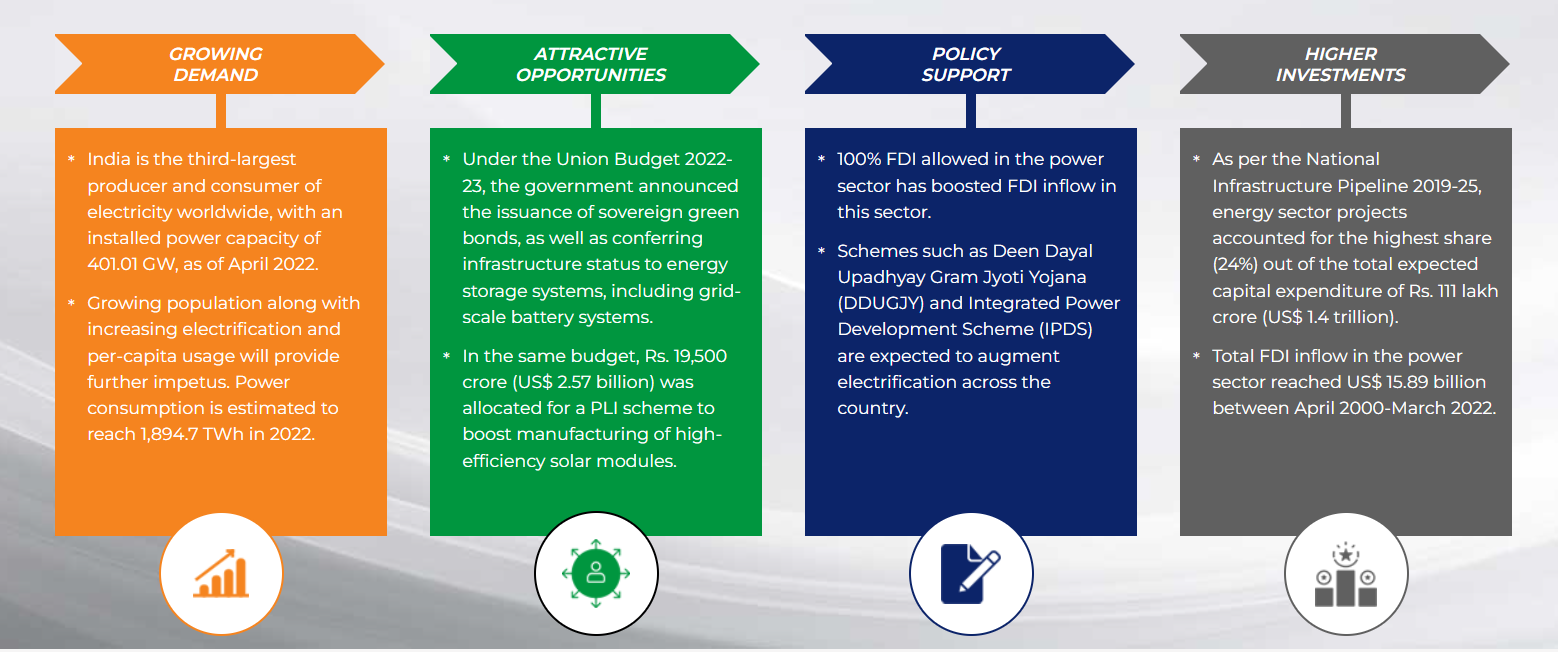Self-reliance in Energy Sector | 20 Sep 2022
For Prelims: Renewable Energy, Gas Based Economy, Blending of ethanol in petrol
For Mains: India’s Energy sector, Renewable Energy Transition
Why in News?
The Government of India has been undertaking various initiatives to attract more E&P (Exploration & Production) investment to increase self-reliance in the energy sector.
What is the Background?
- India’s Energy sector is one of the most diversified in the world. Sources of power generation range from conventional sources such as coal, lignite, natural gas, oil, hydro and nuclear power, to viable non-conventional sources such as wind, solar, agricultural and domestic waste.
- India was ranked fourth in wind power, fifth in solar power and fourth in renewable power installed capacity, as of 2020.
- Near-universal household access to electricity was achieved in 2019, meaning that over 900 million citizens have gained an electrical connection in less than two decades.
- But, the per capita electricity consumption in India is only one-third of the global average, even though the demand for energy has doubled.
- So, to catch up with the increasing demand for energy, there is a need to make arrangements for a secure and sustainable form of self-reliance in the energy sector.
What is the need of Becoming Self-Reliant in the Energy Sector?
- India is not energy independent. It spends over Rs 12 lakh crore on importing energy.
- The government is planning to get energy independence before 100 years of independence is completed i.e., by 2047.
- As green power takes precedence in the global scheme of things, the Indian government has already kick-started its green hydrogen journey.
- For a nation, 85% dependent on imports for meeting its oil needs and 50 % for gas requirements, the key is alternate energy sources - from renewable power to hydrogen and switching to electric vehicles from current petrol and diesel-run automobiles.
- From solar energy to Mission Hydrogen to adoption to EVs, we need to take these initiatives to the next level for energy independence.
- India is the world's fifth largest producer of ethanol after the US, Brazil, EU and China. Ethanol worldwide is largely used for consumption but nations like Brazil and India also dope it in petrol.
- Self-reliance through green energy initiatives is the foundation of a green and sustainable economy. Green energy initiatives focus on clean energy and its availability to all individuals and businesses.
What are the Government’s Achievements in the Energy Sector?
- The target of supplying petrol mixed with 10% ethanol (10% ethanol, 90% petrol) was achieved in June 2022, ahead of the original schedule of November 2022.
- Encouraged by the success, the government advanced the target of making petrol with 20% ethanol by five years to 2025.
- As of March 2021, 2.82 crore households have been electrified under Pradhan Mantri Sahaj Bijli Har Ghar Yojana, “Saubhagya”.
- By June, 2022, over 36.86 crore LED bulbs, 72.18 lakh LED tube lights and 23.59 lakh energy-efficient fans have been distributed across the country, saving around 48,411 million kWh per year and Rs. 19,332 crores in cost savings.
- As of June 2022, over 44 lakh smart metres have been deployed under the National Smart Grid Mission (NSGM), with a further 67 lakhs to be deployed.
- Solar tariffs in India have reduced from Rs. 7.36/kWh (US 10 cents/kWh) in FY15 to Rs. 2.45/kWh (US 3.2 cents/kWh) in July 2021.
- India’s rank jumped to 22 in 2019 from 137 in 2014 on World Bank’s Ease of doing business - "Getting Electricity" ranking.
What are the Initiatives to Achieve Self-reliance in the Energy Sector?
- Gas Based Economy:
- Blending of Ethanol in Petrol
- Prime Minister Ujjwala Yojna
- Renewable Energy Initiatives
- National Hydrogen Mission
Way Forward
- India must exploit solar and wind energy, and especially green hydrogen energy, in its electricity system to meet the ever-increasing energy demand.
- The aspects like investment, infrastructure development, private-public partnership, green financing, policy framework need to be strengthened both at the national level and regional level to cater to inclusiveness in the development process.
- Green energy has tremendous potential in contributing to income, employment, and entrepreneurship and undoubtedly fosters sustainable development.
- In addition to job and income generation, it opens up opportunities/avenues for investment and markets for new products and services. So, India should focus on achieving green energy and self-reliance in the Energy Sector together.
UPSC Civil Services Examination Previous Year Question (PYQ)
Q1. Write a note on India’s green energy corridor to alleviate the problem of conventional energy. (2013)
Q2. India has immense potential of solar energy though there are regional variations in its developments. Elaborate. (2020)
Q3. Do you think India will meet 50 percent of its energy needs from renewable energy by 2030? Justify your answer. How will the shift of subsidies from fossil fuels to renewables help achieve the above objective? Explain (2022)

